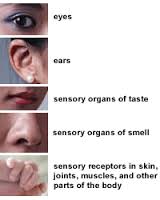SENSE ORGANS
Sense organs receive the internal and external stimuli and convey it to the central nervous system.
The main sense organs are as follows:
EARS:
The organ of hearing or ear can be divided into three parts; the external , the mid and the internal.the external ear consists of the pinna and the external auditory meatus. It collects sound waves. The middle is the air filled tympanic
cavity. The internal ear has the membranous labyrinth which consists of vestibule, the cochlea and the semicircular canal.
EYE:
The eyeball lies in an orbit together with nerves and muscles to move it . The eye is the organ of vision. It has a complex structure consisting of a transparent lens that focuses light on the retina. The retina is covered with two basic types of light-sensitive cells-rods and cones. The cone cells are sensitive to color and are located in the part of the retina called the fovea, where the light is focused by the lens. The rod cells are not sensitive to color but have greater sensitivity to light than the cone cells. These cells are located around the fovea and are responsible for peripheral vision and night vision. The eye is connected to the brain through the optic nerve. The point of this connection is called the “blind spot” because it is insensitive to light. Experiments have shown that the back of the brain maps the visual input from the eyes.
SMELL:
The peripheral olfactory organ or organ of smell consists of two parts: an outer, the external nose, which projects from the center of the face; and an
internal, the nasal cavity, which is divided by a septum into right and left nasal chambers. Smells get inside the nose and nerves send message to the brain what kind of smell they are.
TASTE:
Organs of taste are buds on the tongue and the roof of buccal cavity. When anything touches our tongue the specific nerves tells the brain the particular
taste.
Also Read: Weird facts about Human Body
